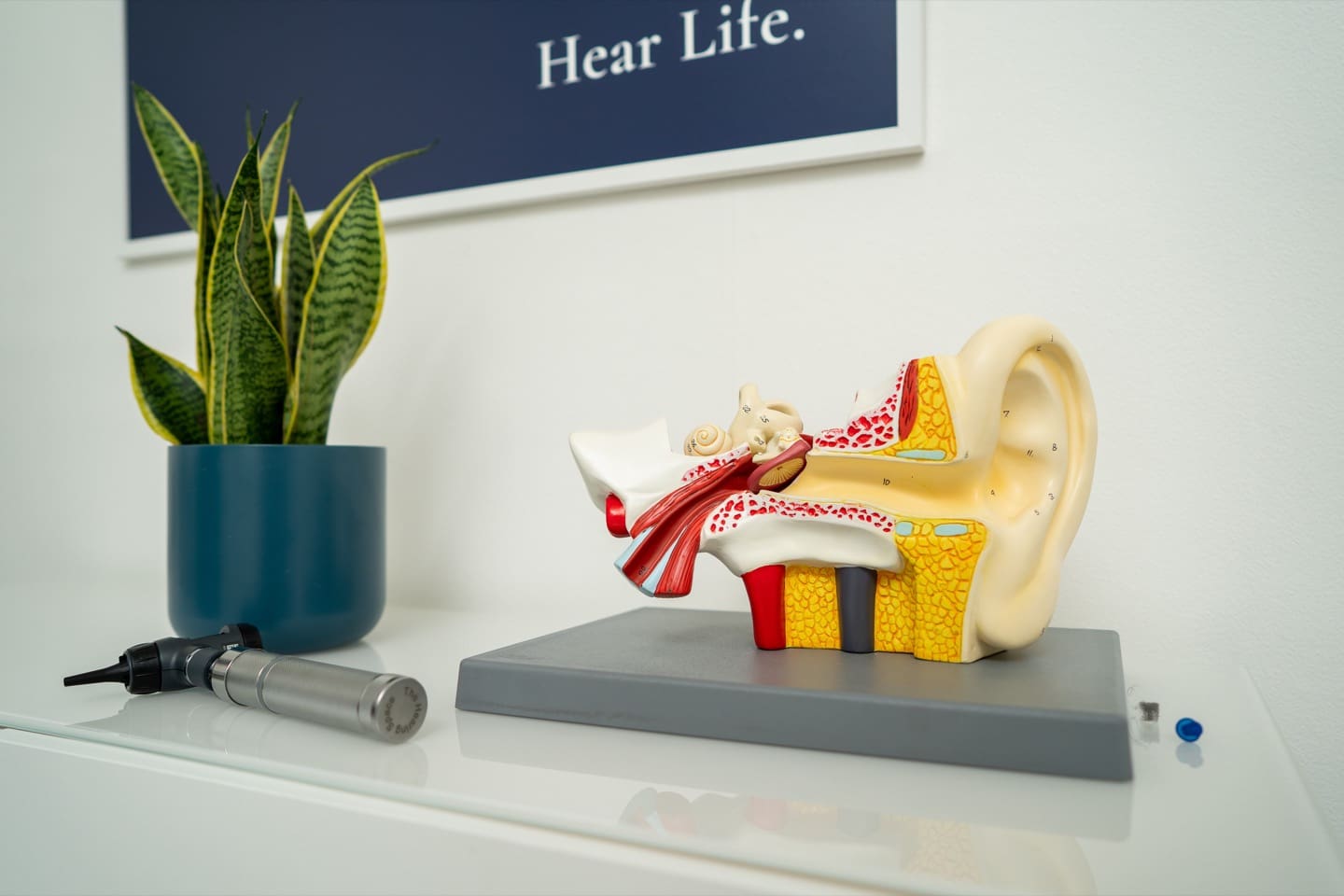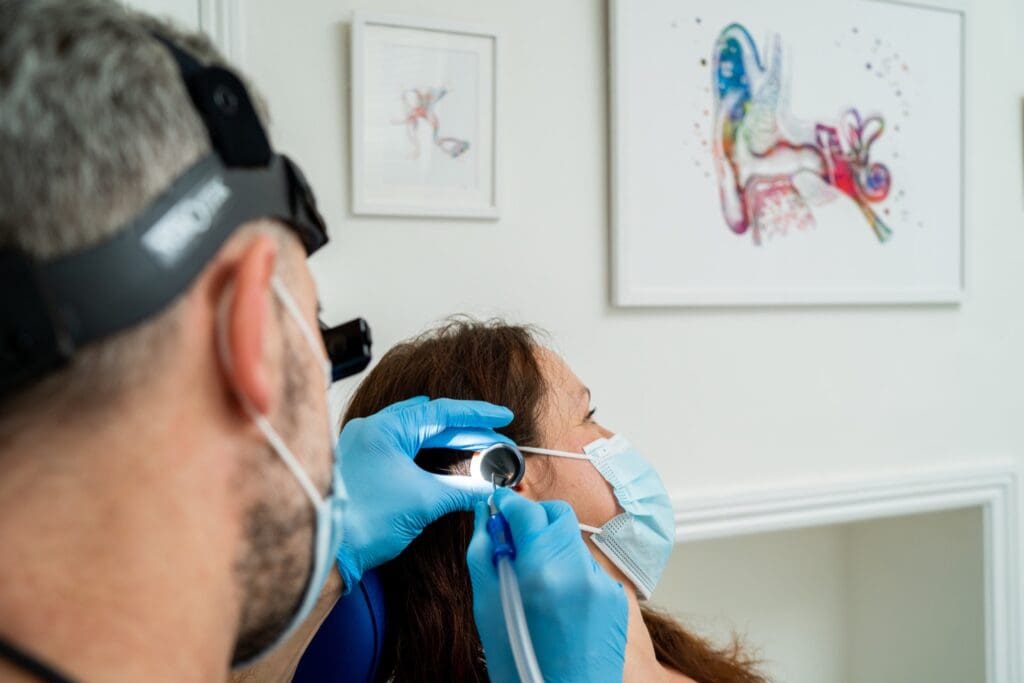What is earwax?
Earwax, sometimes called cerumen, is completely natural and healthy occurring substance that is composed of oils secreted from skin cells in the ear canal mixed with dead skin cells. It has several important functions when it comes to protecting our ears. Primarily it serves as a natural barrier to protect our ears by trapping dust, bacteria, and other debris. Earwax also keeps the ear canal moisturised to prevent dryness and itchiness.
Wax also serves as a natural cleanser as it moves from inside the ear canal outward, gathering dead skin cells, hair, and dirt along the way. There is a natural mechanism where the wax migrates from deeper in the ear canal out to the opening where it can be swept or wiped away. This process involves migration of skin cells facilitated by movement of the jaw that occurs during chewing. Tests have shown that it has antibacterial and antifungal properties. If your ears don’t have enough earwax, they’re likely to feel itchy and uncomfortable. Often, earwax falls out of the ear when we wash or sleep and for most people it doesn’t become problematic. That being said, occlusion from ear wax is one of the most common ear-related problems for which people see clinicians. Because of these beneficial aspects of cerumen, the clinical practice guidelines usually recommends against removal of non-impacted wax.
Why do I produce too much ear wax?
Ear wax is perfectly healthy but there could be a number of reasons why you may be producing an excess amount of earwax. Several factors can interfere with this natural ear cleaning process. These include unusually narrow ear canals, as seen in children and some adults, blockage from ear plugs or hearing aids, drying of earwax due to spending a lot of time in dusty or dry environments, or occasionally from over production. But it could also be because of your age, as you get older you are more likely to produce harder and drier wax.
Signs and symptoms of excessive earwax
When earwax builds up and causes symptoms, or in instances where examination of the ear is necessary and the earwax blocks examination, this is called a wax impaction. The ear canal can be up to 80% occluded before most people will notice a change in hearing. For some people, the wax can build up and can lead to a complete blockage of the ear canal which can have significant consequences. This can often occur following swimming or getting water in the ears, due to the expansion of hard wax. Also, using cotton buds to attempt to remove wax can also cause impaction by pushing any wax deeper into the canal. In these instances of symptoms caused by obstructing wax or when examination is warranted but not possible, removal of the wax is indicated.
The signs of earwax build-up include hearing feeling muffled, earache, a feeling of the ears being plugged, tinnitus (ringing in the ears), itching, and a sensation of fullness in the ear. An excess of earwax can also sometimes be painful. Typically, any hearing loss associated with earwax is of a conductive type and is similar to how we hear when we block our ears with our fingers. If there is no underlying permanent hearing loss, then wax can typically produce a loss of 20 – 40 dB, which can significantly affect someone’s ability to hear.
What should I do if I think my ears are blocked?
Seeking the advice of a hearing care specialist is the best course of action if you suspect a wax impaction. Using specialist techniques and equipment, a professional can examine the ears safely and determine if earwax is indeed a problem and the best strategy to deal with it. Historically, irrigation of the ears with water was used for removal of wax. More recently, newer techniques involving microsuction (a gentle suction device) and specialist tools have been used alongside specialist viewing equipment (microscopes or endoscopes) although sometimes water methods are still used in some cases.
What is microsuction?
Microsuction at ‘The Hearing Space’ in Leedsis a gentle and effective method for removing wax. It uses a thin metal tube to gently suction the wax out. This is typically carried out with a microscope to allow the practitioner to see the ear clearly which results in a safe and effective procedure. Sometimes, additional instruments are required to gently dislodge any difficult to remove wax. Also, for some people, a second visit may be required to allow for some wax softening products between visits. Wax removal using microsuction is usually painless and at The Hearing Space we allow a minimum of 45 mins for each appointment.
The use of drops for wax softening
If the build up of wax is hard, it may require softening to allow removal. Typically, medical grade olive oil is first used in an attempt to soften wax. Sometimes, alternative eardrops are required to break up very hard wax. Using too many drops prior to seeking the advice from a hearcare professional, can in some cases, make it more difficult to remove the wax. Therefore, we would always recommend seeking advice as early as possible, if you think your ears may be blocked with earwax.
Special considerations
Anyone that used hearing aids or hearing devices is more likely to require action to remove earwax. Not only can the hearing instrument interfere with the normal cleaning mechanism of the ear, but the wax can damage or impair the function of the hearing aid. Accordingly, any patient that wears hearing aids should have an ear exam whenever they encounter a trained clinician and any wax, obstructive or not, should be removed.
Additionally, there are some individuals that may be unable to convey or recognise the symptoms associated with impacted wax. Children, developmentally delayed adults, or cognitively impaired elderly patients will benefit from an assessment for impacted earwax and removal if identified. There are several studies showing improved hearing and cognitive function in patients after removal of obstructive cerumen in these populations
Conclusions
Whilst talking about earwax may not be the most pleasant topic for some, most people require only education and reassurance of the health benefits of earwax. If, however, earwax becomes problematic or prevents examination of the ears by a hearcare professional, then ear cleaning is warranted and should be performed either at home or in the office with one of the safe methods described.
To arrange an appointment for your ears to be assessed for wax impaction, please call 0113 8730444 or contact us at hello@thehearingspace.co.uk
Home visits can be carried out and anyone who invests in a hearing rehabilitation package with ‘The Hearing Space’ will automatically receive regular ear examinations and ear cleaning if required.
What our clients say?
“Fantastic service from start to finish. After suffering with hearing problems for a few days I thought I’d get it checked out. I’m glad I did. After an initial assessment and a good clean my hearing is back to normal. Thank you” Jonathan
“Really great service, Paul was very professional and thorough. I can now hear again with the reassurance that both ears were fully checked. Highly recommended.” Helen
“Very thorough consultation for ear wax removal and Paul was very thoughtful for my elderly mother’s wellbeing during the procedure.” Judith
“I came to the hearing space as i had a blocked ear that wouldn’t go away. Paul was very friendly, and his experience and knowledge was fantastic. 40mins later and my ear was back to normal. I would strongly recommend The Hearing Space.” James
“Paul is extremely knowledgeable and friendly. The procedure was quick and efficient, was also very interesting seeing the inside of my ear via camera linked to his screen. Enjoying being able to hear again. Cannot recommend enough!” Iain P
“Paul is a rare individual in that he combines empathy with a mountain of knowledge and is genuinely concerned with helping his patients. I cannot recommend him highly enough.” Stuart B
“I had a blocked ear and visited The Hearing Space for micro suction treatment to remove ear wax. My condition was difficult to treat, but Paul was very kind, patient and persistent. He was able to restore my hearing and recommend a specialist for further treatment.” Justin


